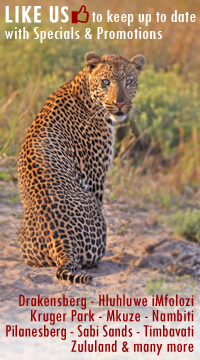
The Big Five
Kruger National Park - Kruger Park Bookings
The Big Five
Kruger National Park - Kruger Park Bookings
This term The Big Five, originated in the 1800's as; "The five most dangerous animals in Africa to hunt."
Panthera leo - The African Lion
The largest of our feline species. Originally found throughout Africa from the Barbary Lion of North Africa to the Cape Lion (now extinct) of the southern extremity of South Africa. This tawny animal blends into the grasslands so well that even if a short distance from the roads an entire pride would hardly be visible. One is not able to
leave the road network in the Provincial and National Parks in South Africa, whereas on the private game farms in the Sabi Sands one is able to drive right up to these recumbent felines at their day-time repose and secure uninterrupted views and photographs close at hand.
Panthera pardus - Leopard
Possibly our most beautiful of the large cats in South Africa - an elusive nocturnal animal which is normally very difficult to view. Here in the Sabi Sands the leopard has over time, become more habituated to the vehicles that track them into and
through the bush in order to secure close sightings. Without exception all the Lodges within this protected area are host to leopard and visitors enjoy regular sightings.
Loxodonta africana - African Elephant
The largest land animal in the World and the largest of the Elephantidae.
This highly intelligent animal is a favourite and to find a mature bull one appreciates the magnificence of such an enormous pachyderm. A breeding herd can entertain for ages, watching as the young and old interact. Your Ranger would give an insight to their behaviour whilst always keeping vigilant attention of the matriarch and her
siblings, ensuring your safety.
Ceratotherium simum - White / Square -lipped Rhinoceros
Diceros bicornis - Black / Hook-lipped Rhinoceros
Africa hosts two Rhino species. I would say that it was the Black Rhino that justifiably earned the reputation as an extremely dangerous animal to hunt. The White Rhino can be dangerous, as all wild animals are, but this, the larger of the two species is noticeably more placid.
The White Rhino - Larger than the Black with a large nucal hump at the base of the neck, an extended elongated head and the square lips with which they are able to graze the grasses of the open savannahs, their preferred ecozone. Favouring the open grasslands renders these animals more visible and with their calmer temperament one should enjoy good viewing of this vulnerable animal persecuted for its horns.
The Black Rhino - An inquisitive short-sighted animal that advances on a deemed intrusion - possibly to secure a better look? Sometimes they advance rather rapidly hence their reputation
of being cantankerous. A browser with adapted prehensile lips to facilitate this, thus preferring the thickets and wooded areas, makes for difficult sightings of this very threatened species. Rare in the area.
Syncerus caffer - African Buffalo
Herds of many hundreds occasionally move through the area with resident populations in smaller herds. Although regarded by the early hunters as the most cunning of all the animals, and consequently the most dangerous to hunt, this is true
only of those at bay, wounded or if one of the old "dagga boys" - males who have been chased out of the breeding herds by the younger more virulent and stronger males, to live their retirement alone. In some cases they join up with others in a similar predicament. These groups of two or three, spend much of their day wallowing in mud-holes ruminating - hence their name 'dagga' which is the African word for mud (and not some local weed).
Hunting does still occur in Africa, but today, in the protected areas in and around the Kruger National Park, the high profile animals are assured of some protection and today the persecution and hunting of the Big 5 is limited, with an emphasis instead
on photographic safaris. Two of the more difficult and desirable animal species to find are the Cheetah and the African Wild Dog. Along with the Big 5 these make up the most sought after specie to view. Where the animals are not able to be tracked off-road, such as in the National and Provincial Parks, sightings of these animals is by luck alone. The private Lodge owners have also created a radio network whereby the individual vehicles are able to report any interesting sighting and afford others traversing in that area the opportunity to make the sighting.
Acinonyx jubatus - Cheetah
The fastest land mammal on Earth. With its diurnal habits this mostly solitary cat is regularly seen. It prefers the open grasslands and less bushy areas so that it may more easily run down its prey.
Lycaon pictus - Wild Dog
These painted wolves are susceptible to all canid diseases, have vast hunting ranges extending to outside of the protected areas and are thus vulnerable to persecution.
The population of these pack animals has been drastically reduced rendering their future uncertain and threatened. Crepuscular in habit, active early mornings and late afternoons into the evening these animals are fairly regularly found in the area and especially when breeding as they remain close to their den.
The Little Five
A fun definition which incorporates the name of the Big 5
So the Little Five are;
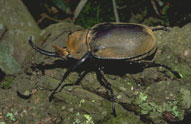 Rhinoceros Beetle |
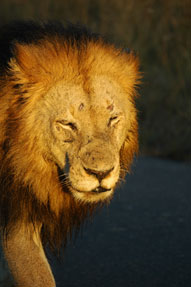 Lion |
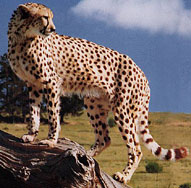 Cheetah |
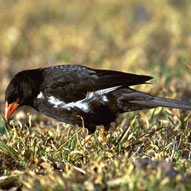 Red-billed Buffaloweaver |
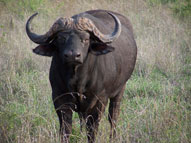 Buffalo |
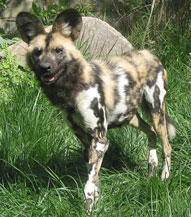 Wild Dog |
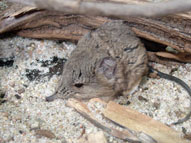 Elephant shrew |
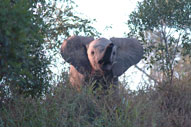 Elephant |
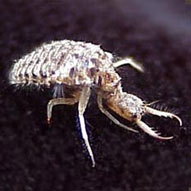 Ant Lion |
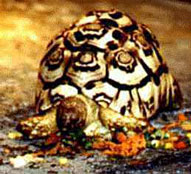 Leopard Tortoise |
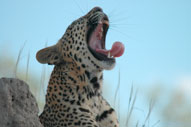 Leopard |
|
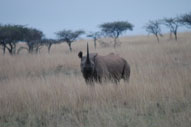 Rhino |


